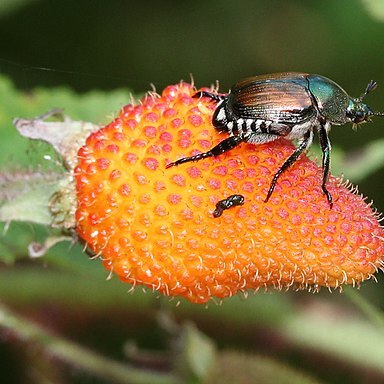Erect or scrambling to semi-scandent shrubs, up to 2 m high. Stems with many up to 5 mm long gland-tipped, reddish, setose hairs and usually also with soft, curly hairs, prickles usually not many, curved, up to 5 mm. Sessile, pale or red globular glands often present on many parts of the plant, especially the leaves. Leaves imparipinnate, up to 21 cm long, petiole (l-)2-6 cm long. Stipules linear, 3-6 by up to 0.5 mm, entire. Leaflets in 2-3(-4) opposite pairs, oblong to oblong-ovate, 2.5-7 by 0.8-2 cm, base acute to rounded, margin serrate to biserrate, apex acute to long-tapering, herbaceous, 7-12 pairs of nerves, soft-hairy on both surfaces and with gland-tipped long hairs. Inflorescence consisting of up to 5(-8) cymes in the axils of the upper leaves, up to 25 cm long, with up to 20 flowers. Bracts in the cymes often leaf-like. Pedicels up to 4 cm long. Hypanthium 4-5 mm across, with some soft hairs and with gland-tipped setose hairs outside. Sepals narrowly triangular, 7-14 by 2-3.5 mm, including the up to 5 mm long acumen, indumentum outside as hypanthium and also woolly on the covered margins. Petals falling early, oblong to obovate, 8-10 by 2-4 mm, obtuse, slightly fimbriate at apex, white. Stamens up to c. 120, filaments up to 4 mm, anthers 0.5 mm long. Pistils up to c. 500, ovaries glabrous, on elevated, glabrous torus with pistils down to the base, style up to 2 mm long. Collective fruits ellipsoid, up to 1.5 by 0.8 cm when dry, sepals recurved. Fruits 1-1.5 mm long, orange-red to red, mesocarp only a very thin layer when dry.
A sprawling shrub. It has glandular red hairs and hooked prickles 3-4 mm long. The leaves have leaflets along the stalk and are 5-12 cm long. There are 5-7 oval leaflets 3-5 cm long y 2-3 cm wide. The base is obliquely rounded. There are irregular teeth. The veins have curved spines underneath. The flowers are white and can occur singly or as several in a group. The fruit are oval and 1-1.5 cm long. They are orange-red.

